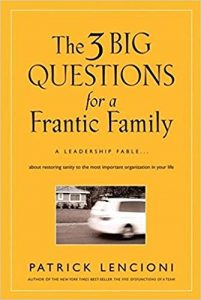The 3 Big Questions for a Frantic Family
by Patrick Lencioni
 Do you think families could benefit from a little more “organizational clarity” — the sort of clarity sought during meetings in businesses, corporations and other social institutions that stand to lose if they do not keep their core identity, purposes and objectives well in mind?
Do you think families could benefit from a little more “organizational clarity” — the sort of clarity sought during meetings in businesses, corporations and other social institutions that stand to lose if they do not keep their core identity, purposes and objectives well in mind?
That, basically, is the question posed by “The 3 Big Questions for a Frantic Family” by business writer Patrick Lencioni. His answer, it seems, is yes and no.
Yes, families would benefit from time spent recalling and clarifying their identity purposes and values, and even from putting a simple plan in place to assure they are on track for achieving the goals most important to them.
But no, families are not businesses. Families will need to keep things somewhat simple, so to speak, and not get lost in charts, spread sheets or lengthy reports.
Lencioni describes himself as a “management consultant who helps CEOs and other leaders build healthier organizations with greater context and clarity.” He also is a husband and parent, who readily admits that “our family is as frantic and chaotic as the next one.”
The frantic, chaotic nature of much family life today is, of course, what prompted Lencioni to write this book. He says that most families he knows would admit they either are “reactive, scattered, frantic, chaotic” or “stressed.”
One wife and mother puts it this way in the book: “We just do what needs to be done until everyone’s in bed and we can rest. Then we get up the next day to do it again.”
With such considerations in mind, Lencioni explains that his book’s purpose is “to help you run your family with more clarity and context and purposefulness by provoking you to answer three simple questions that can change your life.” His three big questions are:
1. “What makes your family unique?”
2. “What is your family’s top priority – rallying cry – right now?”
3. “How do you talk about and use the answers to these questions?”
The book’s first part is presented as a fable. Its storytelling approach introduces a couple the author calls Theresa and Jude, and the process that led them over time to formulate this response to the first of the three questions:
“We’re a large, close family where the parents are immersed in the lives of their children. The family’s life is centered around church and faith, and we believe in being passionate and emotionally invested in everything we do.”
Theresa and Jude decided to take steps “to spend more peaceful, alone time together as a family.” That would entail, among other things, difficult decisions related to extracurricular activities, Jude’s business travel and cutting back for the whole family on TV viewing. It would entail, moreover, a 10-minute weekly meeting for the couple “to assess how well we’re doing.”
This couple’s briefly stated plan for their family pointed to the importance of maintaining a “vibrant faith life,” working to keep healthy, being responsible about finances, helping their children “become well educated” and keeping their “marriage strong.”
Jude, a businessman, confesses that families are different from businesses. Still, he adds, “if every family knew what made them unique and what their rallying cry was, they’d be exponentially clearer and more focused.”
In a conversation with Theresa, Jude at one point asks, “What is it that you want to be different in our lives six months from now?” Theresa responds that when the question is put that way, “the answer’s easy. … We need to spend more time together as a family.”
Helpful insights for families surface throughout this book in the voices of its business people, spouses and parents. One advises: “Forget what you wish you were, or what the perfect family next door is, and focus on what you are at your core.” Another advises: “If you try to be everything you end up being nothing. You have to focus on what’s most important.”
Lencioni believes that “society is facing a serious epidemic of chaos in families, the cost of which is both real and painful.” These costs appear in the forms of poor health, financial difficulties and even divorce, he notes.
His hope is that answering and acting upon the “three big, simple questions” proposed by his book will help “restore sanity and clarity to our families.”
About the reviewer
David Gibson served for more than 37 years on the Catholic News Service editorial staff.
Disclaimer: Book reviews do not imply and are not to be used as official endorsement by the USCCB of the work or those associated with the work. Book reviews are solely intended as a resource regarding publications that might be of interest to For Your Marriage visitors.




